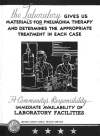The changing fate of pneumonia as a public health concern in 20th-century America and beyond
- PMID: 16257952
- PMCID: PMC1449499
- DOI: 10.2105/AJPH.2004.048397
The changing fate of pneumonia as a public health concern in 20th-century America and beyond
Abstract
For a brief period from the 1930s through the early 1940s, public health advocates made pneumonia a leading public health concern. Predicated on the need for antipneumococcal antiserum, but also incorporating physician reeducation, state "pneumonia control programs" were established nationwide. However, with the advent of penicillin and the sulfonamides, the pneumonia control programs soon collapsed. Pneumonia reverted to the domain of the private practitioner, which was devoid of state oversight. With the emergence of pneumococcal antibiotic resistance in the 1990s, the possibility again arose that pneumonia could become a public health concern, given the nationwide need to curb unnecessary antibiotic usage and to encourage vaccination. An understanding of the history of pneumonia's changing status could shed light on current attempts to reformulate the disease and elucidate the contested domains of private practice and public health.
Figures




References
-
- See Pneumonia: Mortality and Measures for Prevention (Washington, DC: US Treasury Department and US Public Health Service, 1938); “Parran Urges Funds for War on Pneumonia,” Washington Post, November 13, 1937; “Progress of Programs for Pneumonia Control,” Bulletin of Lederle Laboratories 6 (1938): 118–119.
-
- For earlier assessments of pneumonia’s brief transformation into a national public health concern, see Harry F. Dowling, “Frustration and Foundation: Management of Pneumonia Before Antibiotics,” Journal of the American Medical Association 220 (1972): 1341–1345; Harry F. Dowling, “The Rise and Fall of Pneumonia-Control Programs,” Journal of Infectious Diseases 127 (1973): 201–206. - PubMed
-
- Osler William, The Principles and Practice of Medicine (New York: D. Appleton and Company, 1892), 529.
-
- Klemperer G. and F. Klemperer, “Versuche uber Immunisiring und Heilung bei der Pneumokokkeninfection,” Berlin Klinische Wochenschrift 28 (1891): 833–835; as discussed in Edwin A. Locke, “The Serological Treatment of Lobar Pneumonia,” Boston Medical and Surgical Journal 190 (1924): 196–203.
-
- Dochez A. R. and L. J. Gillespie, “A Biologic Classification of Pneumococci by Means of Immunity Reactions,” Journal of the American Medical Association 61 (1913): 727–730. Cole had been influenced in this regard through visiting Fred Neufeld’s laboratory in Berlin, where Neufeld had already begun such subclassification. See Rufus Cole to F. Neufeld, April 22, 1910; F. Neufeld to Rufus Cole, April 3, 1912; both in the Rufus Cole Papers, American Philosophical Society, Philadelphia (hereafter called RCP). Regarding parallel efforts by F. Spencer Lister in South Africa at the time, see Robert Austrian, “Of Gold and Pneumococci: A History of Pneumococcal Vaccines in South Africa,” Transactions of the American Clinical and Climatological Association 89 (1977): 141–161. Regarding the prevalence of pneumococci as agents of lobar pneumonia, see Oswald T. Avery, H. T. Chickering, Rufus Cole, and A. R. Dochez, Acute Lobar Pneumonia: Prevention and Serum Treatment (New York: Rockefeller Institute for Medical Research, 1917), 7.
Publication types
MeSH terms
Grants and funding
LinkOut - more resources
Full Text Sources
Medical

